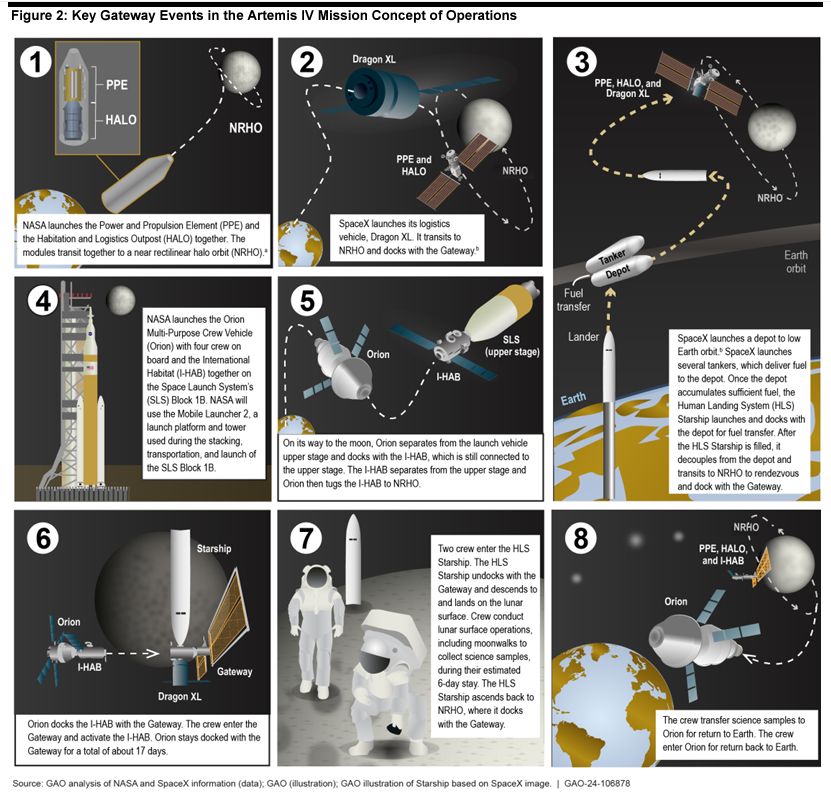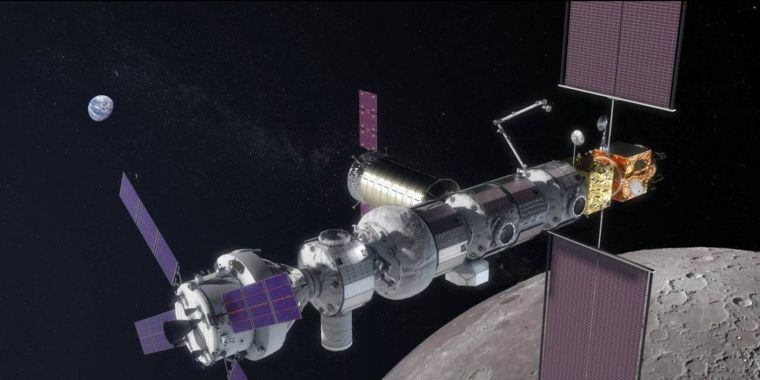National Aeronautics and Space Administration (NASA)
Remember the Lunar Gateway? If not, you’d be forgiven. The project is still being worked out by NASA planners, and it’s not yet entirely clear what the purpose of a lunar space station is.
The Gateway, a small space station that would fly in a halo orbit around the moon and spend most of its time away from the lunar surface, was originally scheduled to launch in 2022. That obviously didn’t happen, but now, New report from the U.S. Government Accountability OfficeThe space agency does not expect the Gateway’s initial elements to launch until at least December 2027. The baseline cost estimate is $5.3 billion.
NASA’s current plans call for using the Gateway as part of the Artemis IV mission, currently scheduled for September 2028. Unfortunately, the Gateway’s current launch target is already three months behind where it needs to be to support Artemis IV, the second mission to land humans on the Moon. But that’s OK, because there are so many other moving parts to the mission that it could successfully launch anytime in this decade.
The report includes a helpful cartoon explaining the complex steps required for the Gateway to participate in the Artemis IV mission.
- Launch the Gateway’s initial segment, power and propulsion module, and habitation module into lunar halo orbit.
- SpaceX Dragon XL rocket launches carrying supplies to the Gateway
- It will launch multiple SpaceX Starships, refuel a Lunar Starship, and fly to the Gateway and dock there.
- A NASA Space Launch System rocket launches carrying four astronauts aboard the Orion spacecraft and a separate Gateway module.
- After launch, Orion will separate from the rocket and dock with this module, the International Habitat.
- Orion will tow the International Habitat to the Gateway for docking, and the crew will disembark aboard.
- Two crew members board the Lunar Starship and spend six days on the Moon.
- The Starship returns to the Gateway, and the four astronauts return to Earth aboard Orion.

How the Artemis IV mission will (probably) work.
U.S. Government Accountability Office
The report is modest, but notes that the plan is highly complex and faces significant schedule risks.
“The mission will be complex because NASA will need to coordinate seven NASA programs, multiple contractors supporting those programs, and international partners to carry out the mission,” the report said. “It will also mark the first launch of an upgraded version of the Space Launch System rocket.”
Developmental disorders
The report also reveals that the Gateway project faces some pretty serious technical problems, including a flaw in the networking chip that enables communications across the lunar space station. If this chip fails, it could cause a myriad of problems onboard the Gateway.
“For example, these flaws could cause the flight computers to restart unexpectedly,” the report states. “If the network is not functioning properly, it could result in loss of control of the gateway. Program officials are also concerned that additional flaws in the communications network may be identified, based on the number already found.”
Another risk is something called “stack controllability,” which basically means that because SpaceX’s Lunar Starship is so much larger than the Gateway, the Gateway’s power and propulsion elements (PPE) won’t be able to maintain the proper orientation of the entire stack once docked with the space station.
“Program officials estimate that the mass of the Starship lunar lander is approximately 18 times the value NASA used to develop the PPE controllability parameters,” the report states. “According to NASA’s systems engineering guidelines, any delayed requirements or design changes could lead to increased costs and schedule delays.”
The report also includes some grim conclusions about the potential usefulness of the Lunar Gateway for Mars exploration missions (NASA officials have spoken of the Gateway in the past as a staging point for spacecraft and propellant for human exploration missions to the Martian surface). But the “stack controllability” issue poses serious limitations to accommodating large Mars transportation vehicles. Moreover, the Gateway’s planned lifespan of 15 years may not be long enough to sustain Mars exploration missions.
“By 2042, when human missions to Mars are just beginning, the Gateway may have exceeded its planned 15-year orbital lifespan,” the report said.
Overall, the report seems to suggest that the Gateway is significantly behind schedule and will be of limited use for landing on the Moon or Mars. The report suggests that implementing the Gateway at the very time that NASA is trying to establish its lunar surface program will be complicated. But everything else is going smoothly.


